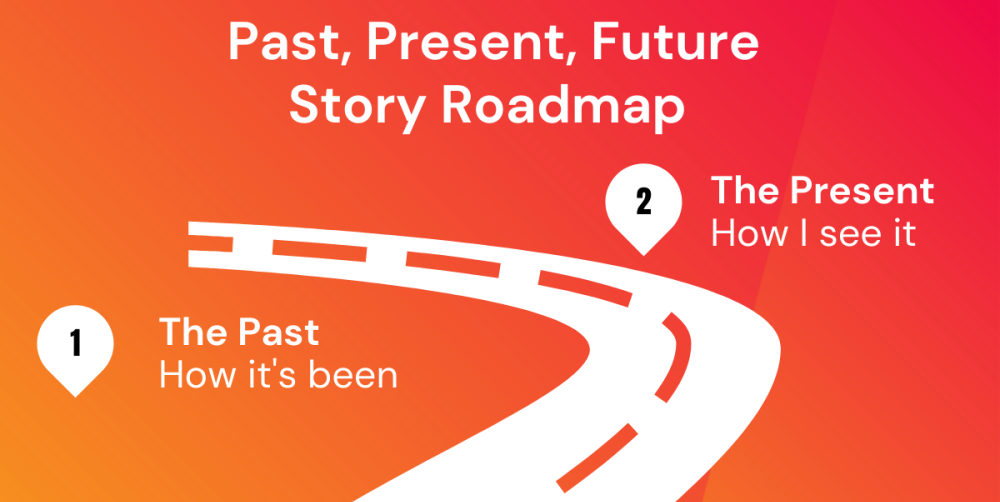Stories are conversation starters that offer insight into you as an individual, what you value, and your perception of the world. As social and emotional beings, our reality is intertwined with others, making our stories worth sharing. Our experiences might be unique, but their reoccurrence makes them relatable. Stories help you connect with your audience while evoking their sense of belongingness, allowing storytellers to become personally invested in their clients’ stories and lives.
Stories need structure to have maximum impact.
The structural flow of a story must address certain elements. My job is to help my clients connect with the value of their journey and translate it into a powerful, meaningful, and moving narration. I hold sessions with my clients to discuss their ideas and opinions as we develop their brand. Over the years, I noticed a pattern emerge, which allowed me to build my own proprietary marketing storytelling methodology.
Introducing a new way to think about your story

The Past – How it’s been
Your journey is unique to you and has challenged you to the point of highlighting a weakness or shortcoming that you see in yourself, your community, or society at large. This is the kind of thing that you see from your vantage point and can’t unsee. When you see it, you know what you are witnessing relates and connects with other people, and you can’t wait to share it with the world!
The Present – How I see it
It would be best if you had a perspective that enlightens others. It could have been difficult, tiring, or frustrating. Or it was enlightening, joyful, and crazy, but it has to be novel and relatable to be meaningful and drive impact. You have a point of view on why and how your experience must immediately address this problem, which you MUST spell out in writing.
The Future – How We’ll change it together
Your resolution to conquer the issue you have uncovered needs immediate attention. But will not be solved alone. Seeing you invested in guiding your story empowers your readers to join your movement. Your story must give people hope. Your audience wishes to see you involved in their stories to create a united force against a common problem. How do you plan to turn the situation in your favor? How can others benefit from it? Time to get people to join you in your movement.
In my professional experience, I have come across incidents of people from all walks of life potent enough to bring change. But what good are your experiences if they cannot positively influence the lives of others? So I help them thread together bits and pieces of powerful moments until they become a vibrant tapestry of human expression and devotion—a story.
A good story is heard, but a great story is lived. So how do you want people to receive yours?
Stories are conversation starters that offer insight into you as an individual, what you value, and your perception of the world. As social and emotional beings, our reality is intertwined with others, making our story worth sharing. Our experiences might be unique, but their reoccurrence is what makes them relatable. Stories help you connect with your audience while evoking their sense of belongingness, allowing storytellers to become personally invested in their clients’ stories and lives.
Stories need structure to have maximum impact.
The structural flow of a story must address certain elements. My job is to help my clients connect with the value of their journey and translate it into a powerful, meaningful, and moving narration. I hold sessions with my clients to discuss their ideas and opinions as we develop their brand. Over the years, I noticed a pattern emerge, which allowed me to build my own proprietary marketing storytelling methodology.
Introducing a new way to think about your story

The Past – How it’s been
Your journey is unique to you, and it has challenged you to the point of highlighting a weakness or shortcoming that you see in yourself, your community, or society at large. This is the kind of thing that you see from your vantage point and can’t unsee. When you see it you know what you are witnessing relates and connects with other people, and you can’t wait to share it with the world!
The Present – How I see it
It would be best if you had a perspective that enlightens others. It could have been difficult, tiring, or frustrating. Or it was enlightening, joyful, and crazy, but it has to be novel and relatable to be meaningful and drive impact. You have a point of view on why and how your experience must immediately address this problem, which you MUST spell out in writing.
The Future – How We’ll change it together
Your resolution to conquer the issue you have uncovered needs immediate attention. But will not be solved alone. Seeing you invested in guiding your story empowers your readers to join your movement. Your story must give people hope. Your audience wishes to see you involved in their stories to create a united force against a common problem. How do you plan to turn the situation in your favor? How can others benefit from it? Time to get people to join you in your movement.
In my professional experience, I have come across incidents of people from all walks of life potent enough to bring change. But what good are your experiences if they cannot positively influence the lives of others? So I help them thread together bits and pieces of powerful moments until they become a vibrant tapestry of human expression and devotion—a story.

